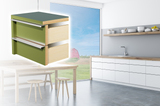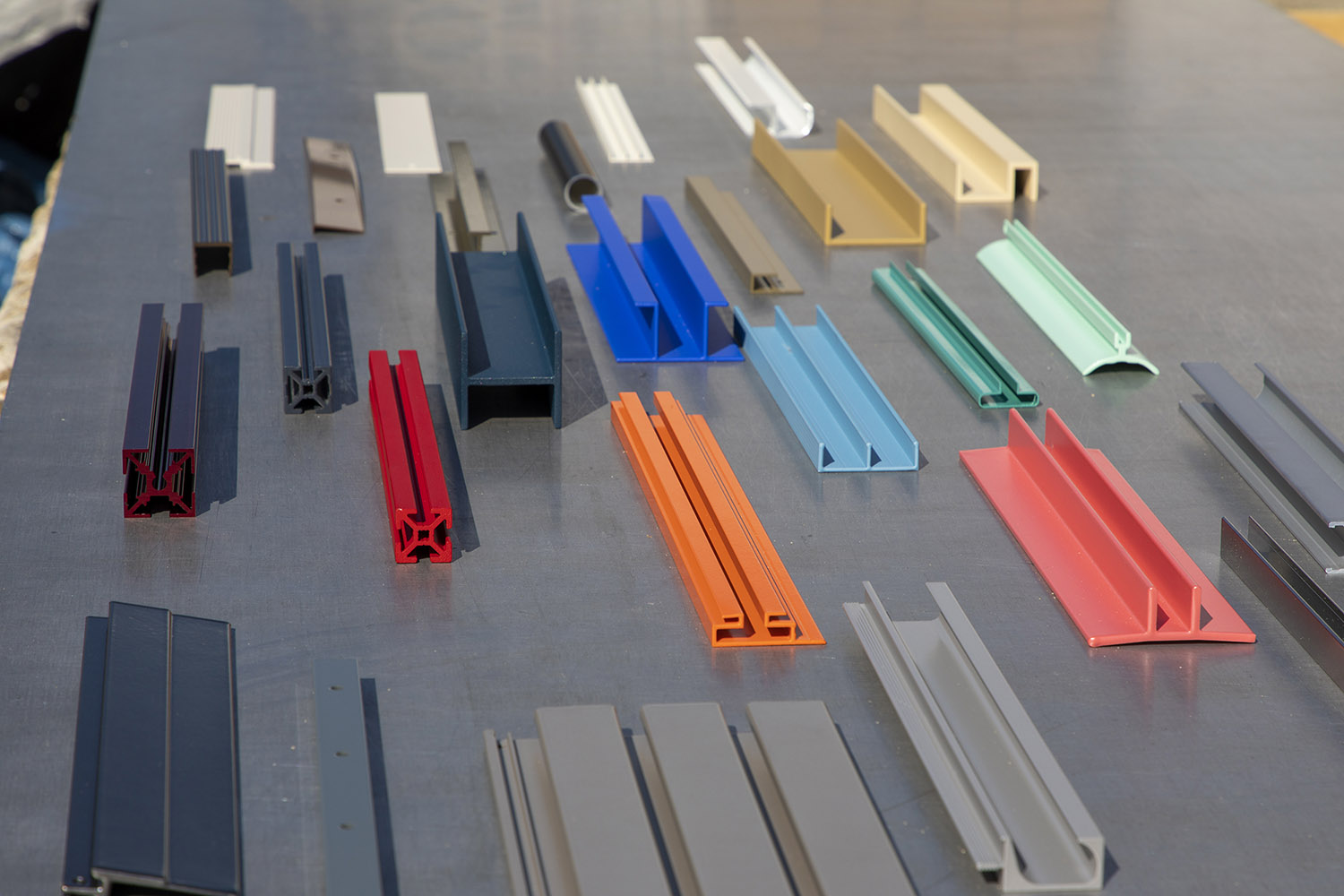Aluminum vs Steel for Retail Displays

A retail display can — and should — function as more than a rack for your products. As a centerpiece, it complements your branding and store’s style to make products pop.
However, you also want your displays to be strong, easily maneuverable and low maintenance, so they don’t end up being more trouble than they’re worth.
To that end, when picking out your retail displays, which material wins when comparing aluminum vs. stainless steel?
About Aluminum
As Earth’s most common metal, we’ve found countless uses for aluminum — from kitchen foil and soda cans to automobiles and airplanes. But it’s not only aluminum’s availability that makes it so popular, as it:
- Has a phenomenal strength-to-weight ratio — evidenced by aerospace applications
- Resists corrosion when anodized
- Is malleable enough to form into virtually any shape, especially via extrusion
- Is cost-effective
- Proves extremely sustainable across all applications
Aluminum is also a non-toxic metal and doesn’t give off volatile organic compounds (VOCs), which are considered significant health hazards.
About Stainless Steel
Stainless steel refers to any ferrous alloy that contains a minimum of 10% chromium to protect against iron’s significant weakness to rust. Steel — stainless or otherwise — is already an iron alloy, primarily formed by adding carbon. With enough chromium blended in, stainless steel creates its own protective, nonporous barrier that inhibits rust from forming.
Stainless steel can be found in:
- Kitchen appliances and cookware
- Medical instruments
- Automotives
- Industrial equipment and tooling
- Storage containers for chemicals and food
Aluminum and (stainless) steel are so prevalent that you’re surrounded by products containing them in your everyday life.
Alloys — Aluminum vs. Stainless Steel
An alloy is a chemical mixture of elements, with a given metal dominating the composition.
Combining small amounts of other metals grants additional properties without sacrificing those desired from the main element, and mixtures are determined according to the ideal characteristics for their applications.
As mentioned above, steel is already a ferrous alloy. It’s a good alternative when iron isn’t strong enough. However, it remains especially prone to rusting, which prompts a need for more-resistant stainless steel.
Pure aluminum, on the other hand, is exceptionally soft. Its malleability would negatively impact many of its current uses, so most applications require aluminum alloys (which are stronger and more durable). In addition to alloy improvements, aluminum can be anodized to increase corrosion resistance further and provide beautiful aesthetics.
Aluminum Alloys
3003 is the designation for the most common aluminum alloy, and — aside from the primary metal — 3003 Aluminum is comprised of:
- Manganese – 1-1.5%
- Iron – Up to 0.7%
- Silicon – Up to 0.6%
- Copper – 0.05-0.2%
- Zinc – Up to 0.1%
3003 aluminum provides increased shear strength, tensile strength and fatigue strength over 1100 aluminum (i.e., “pure” aluminum).
Stainless Steel Alloys
304 stainless steel is the most common version of the alloy, and — aside from iron — 304 stainless steel is comprised of:
- Chromium – 18-20%
- Nickel – 8-10%
- Manganese – Up to 2%
- Silicon – Up to 1%
- Carbon – Up to 0.08%
- Phosphorus – Up to 0.045%
- Sulfur – Up to 0.03%
While stainless steel is generally extremely corrosion resistant to standard atmospheric conditions, the 304 alloy is prone to rust when contacted by chloride solutions or saltwater.
Retail Displays — Aluminum vs. Stainless Steel
When considering steel vs. aluminum for your retail displays, the primary consideration is weight. When comparing equivalent volumes of steel vs. aluminum, the latter weighs roughly 33% of the former. Aluminum weighs 0.0986 lb/in3 compared to 304 stainless steel’s 0.289 lb/in.
Aluminum displays will be significantly easier to move or hang in retail operations — and are, therefore, safer for employees and customers.
Given aluminum’s greater malleability (i.e., deformation under compressive strength) and ductility (i.e., deformation under tensile strength, or “being pulled”) means that the metal can be formed into far more versatile — and custom — shapes via manufacturing processes like extrusion.
Whatever shape or style your retail display needs, aluminum provides.
Crucially, if your retail store will be placing items containing chloride solutions or salt compounds (e.g., hardware or supply stores), both anodized aluminum and stainless steel will eventually suffer from corrosion.
Further Breaking Down the Characteristics
For greater detail, we’ve compared aluminum vs. stainless steel across five categories. A recurring theme is that stainless steel performs better until weight is factored into your considerations.
Cost (and Cost per Volume)
Aluminum costs around $2.79 per pound, whereas 304 stainless steel costs $1.44 per pound (at the time of writing). However, accounting for weight, you’ll obtain roughly 300% more aluminum by volume if you purchase a pound of each.
So for the same volume of steel as one pound of aluminum, you’d pay $4.32.
Strength (and Strength-to-Weight)
Again, stainless steel is materially stronger than aluminum when compared directly. However, aluminum provides a much better strength-to-weight ratio:
- Aluminum:
- Tensile strength, ultimate – 29000 psi
- Tensile strength-to-weight, ultimate – 29000 psi : 1
- Tensile strength, yield – 27000 psi
- Tensile strength-to-weight, yield – 27000 psi : 1
- 304 stainless steel:
- Tensile strength, ultimate – 73200 psi
- Tensile strength-to-weight, ultimate – 24,400 psi : 1
- Tensile strength, yield – 31200 psi
- Tensile strength-to-weight, yield – 10,400 psi : 1
Furthermore, 304 stainless steel and aluminum will begin yielding (i.e., become permanently deformed) at relatively similar pressures. The significant disparity is between their ultimate tensile strengths (i.e., a material’s complete “breaking point”).
This means only 4200 psi separates the two materials before otherwise equivalent retail displays become permanently deformed.
Corrosion Resistance
Both stainless steel and aluminum — especially if the latter is anodized — provide extremely reliable corrosion resistance outside their mutual weaknesses of chloride and saltwater.
The chromium in stainless steel provides a protective layer to overcome iron’s significant susceptibility to rust. Similarly, aluminum becomes a passive material with a light, white powder coating when it naturally oxidizes.
One major difference is that stainless steel is nonporous. However, if anodized, aluminum’s porous oxidation layer is sealed and protected. For all purposes, anodized aluminum will provide superior corrosion resistance (and aesthetics) over non-anodized aluminum.
Cleaning and Maintenance
Both aluminum and stainless steel can be easily cleaned with a gentle soap or diluted vinegar. It’s one of the primary reasons both metal materials are used for cookware and kitchen appliances.
Recyclability
Steel — stainless or not — is the most recycled metal by quantity worldwide. However, no metal surpasses aluminum’s recyclability: 100%.
- The aluminum recycling process saves 95% of energy compared to manufacturing new aluminum products, substantially reducing carbon emissions and oil equivalent consumption (roughly 90 million barrels per year).
- It’s estimated that ¾ of all aluminum ever produced is still actively used today because of its recycling efficiency (above 90% in many industries).
Stainless steel is also extremely recyclable — a 2015 study estimated 85% of products are reused for new stainless steel or carbon steel products — but aluminum clearly wins in a head-to-head comparison.
Enhance Your Retail Displays with Orange Aluminum
When picking out your retail displays, both aluminum and stainless steel provide high-quality options.
But when comparing aluminum vs. stainless steel directly, aluminum provides the optimal choice across customization, cost, strength-to-weight ratio and recyclability. Regarding rust and corrosion resistance and maintenance, the metals are relatively equal.
If you’re looking for a new retail display made from aluminum, Orange Aluminum manufactures over 1,000 extrusion SKUs — and can customize products however you need.
Contact us today to find out how we can enhance your retail display.



